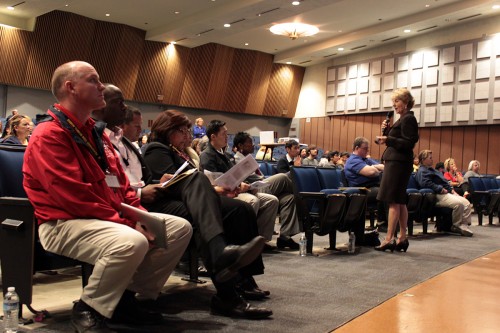AHS Continues Improving Through WASC Accreditation Process

OLIVIA CHEUNG
News Editor
DIANA LI
Staff Writer
In 2009, representatives of Western Association of Schools and Colleges (WASC) visited AHS to validate that the school made improvements since their last visit. Three years later, the WASC team returned to verify whether those improvements were still in effect.
After WASC’s last visit, the school focused on four key goals. Goals one and two were to develop and implement formative standards-based instruction, student evaluations and timely remediation. Goal three focused on improving student learning by utilizing a variety of instructional strategies to support different learning styles and goal four focused on staff collaboration.
School culture is one of the areas that the WASC committee emphasizes in its accreditation process.
AHS has been working to have active parent involvement through a re-energized PTA and communications with parents through sources, such as the Parent Portal and the AHS Facebook page.
“AHS shows diversity in almost every activity that the school offers. Since all students are welcome to participate in any event, such as sports [and] clubs, we always see a combination of people from different cultures,” sophomore Tami Pimentel said.
According to the school’s self-analysis, “Focus on Learning,” compiled by the school faculty for WASC, another part of AHS’ culture would include the availability of community resources, such as the after-school tutoring, the Academy of Future Educators and the Career Center. Together, they provide students with a variety of resources to further their education after high school.
Furthermore, due to the Gateway to Success Program, AHS has experienced a much lower expulsion rate. This program has received national acclaim for its effective approach to intervention for students by treating students with emotional, physical, social and academic needs.
Over the years, there has been a positive shift in academics. The achievement gap is narrowing; CST and STAR scores are improving and open enrollment for Advanced Placement (AP) classes is encouraging more students to challenge themselves.
Many programs exist to support the academic needs of English Learning (EL) students, such as two-hour intensive Structured English
Immersion (SEI) curricula and dedicated Crossroads tutoring.
“Focus on Learning”also discusses AHS’ improvements, which includes allowing families and students to easily access grades and progress through the Student Portal.
The school also has over seventy registered clubs and organizations on campus to cater to the various needs and interests of a diverse
student body.
Areas that AHS is working on involves continuously implementing the Pyramid of Intervention to close achievement gaps and increase the number of students completing A-G requirements, professional development to improve instruction, involvement and communication between the school, parents, students and the community.
School improvements are a joint effort from teachers and students who hold discussions on Collaboration days that range from improving school facilities to encouraging parental and community involvement within the school.
To receive different perspectives, student committees are comprised of students of various backgrounds; some may be national merit scholars while others may be sports enthusiasts.
Though the WASC committee’s visit is over, AHS can still endeavor to improve in years to come.
“I think cultural integration is something that the staff and faculty are very aware of, and we’re very committed to making it better,” School Culture Focus Group Leader Emily Coalson said.